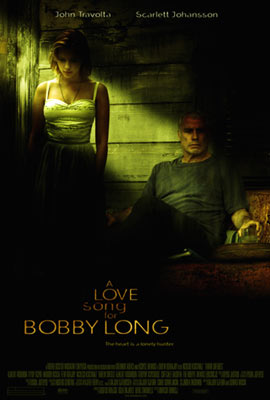A Love Song for Bobby Long review by Cinema Guru Boy
The thing about New Orleans is that if you walk a couple of blocks, you could very well be in another city. Not literally of course. But parts of this city are so disgusting and filthy, only to be the epicenter of culture one block away. And of course it's synonomous with Bourbon Street and alcohol. You could be enjoying the best jazz our country has to offer and follow it up with a mugging 5 seconds later. Well, that's what A Love Song For Bobby Long brings us.The first shots of the film dipict a figure making a cross-town trek with a fifth in hand. The identity of the figure is kept unfocused or shot from the neck down. Of course it's John Travolta, there's little doubt about that, but the idea of who Travolta is this time around is fuzzy. Director Shainee Gabel illustrated this beautifully. After finding out Bobby Long (Travolta) is attending the funeral for an old friend, it is revealed he called Pursy (Scarlett Johansson) to tell her that her mother had died. She hadn't made it to the funeral due to her deadbeat boyfriend, whom she immediately leaves and moves to New Orleans to live in her mom's house with the current tenants, Bobby and his apprentice Lawson (Gabriel Macht) who is a writer being guided by his former college professor. During her arrival to New orleans, we get an amazing tour of the city, showing all sides of this dichotomic city, again courtesy of Gabel.
This movie becomes a coming-of-age flick about two opposing personalities, Bobby and Pursy, trying to live together and the man who has loyalty to one and a crush on the other. The great thing is this never turns into a love story between Lawson and Pursy. Hollywood would've done this, but screenwriters Gabel and Ronald Everett Capps steered this story elsewhere. It's more about Pursy growing up, Lawson fulfilling his potential and Bobby's dark past joined with his reliance to living vicariously through Lawson. The balence of humor and drama is done well and it never is inserted into an inappropriate moment.
Travolta and Johansson have incredible negative chemistry together and they develop their characters very well. Travolta played the alcoholic curmudgeon every bit as well as he did his intense anger scenes. But then came his campfire scene, where he'd entertain the boys with a song, showing his softer side. And at one point he even succumbs to a dance sequence. How do you hold back a smile while watching John Travolta dance? But the genious of this scene is he danced poorly, and it was so endearing, it really fleshed out his character. Recycling his accent from Primary Colors he commanded the screen. I did wonder where all the cajun accents were. In all these New Orlean characters, only Deborah Kara Unger's bartender had a trace of a cajun accent, everyone else's was Southern. Johansson's did seem to fade from time to time, but that's nitpicking.
Now this film was far from a three-act drama. This was about characters interacting. In this situation, the narrative did drag at points. It had its intense moments, but at times, it seemed intent on wandering. Sometimes that's okay, but here the plot needed direction. Often, questions were raised to be answered when the filmmakers were good and ready to answer them, such as why Pursy's estrangement from her mother? And where's the father? And they did this often enough to tie the whole film together and not have it just a year in the life of three unlikable folks. They touched on Bobby and Lawson's alcoholism, but never made the central story. They touched on Lawson and Pursy's flirtation, but never made the central story. They touched on Bobby's past, but dragged it out long enough to bait the viewer along for two hours. The whole story was very subtle.
There's nothing wrong with telling a storywhile restraining yourself the whole time. It can make for a good movie, but in this situation, there's just not enough story to make for a great one.







7 out of 10 Jackasses blog comments powered by Disqus
